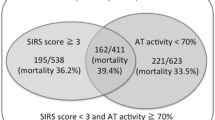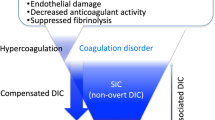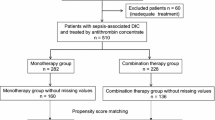Abstract
Thrombin-activatable fibrinolysis inhibitor (TAFI) is a carboxypeptidase that downregulates fibrinolysis and might play some roles in the pathogenesis of disseminated intravascular coagulation (DIC). We prospectively examined the plasma TAFI antigen levels in patients highly suspected to be suffering from DIC. Patients were subdivided into overt DIC and non-DIC groups according to a DIC scoring system. The Sepsis-related Organ Failure Assessment (SOFA) scores were concurrently calculated on patients with sepsis. Overall, there were 23 non-DIC patients and 20 patients with overt DIC. Their baseline characteristics were similar, but patients with overt DIC had much more aberrant coagulation tests and higher lactate dehydrogenase levels. However, there was no significant difference between overt DIC and non-DIC patients regarding their TAFI antigen levels [median/interquartile range (IQR) 74.41/13.98 and 75.29/15.16, respectively, p=0.543]. On regression analysis, TAFI antigen levels were not correlated with either C-reactive protein levels or various coagulation test results. In patients with sepsis (n=31), TAFI levels among three risk groups stratified by low (≦5), intermediate (6–10), and high (≧11) SOFA scores were not statistically disparate (median/IQR 65.24/15.14, 74.63/13.79, and 75.29/21.51, respectively, p=0.684), either. Our result indicated that plasma TAFI antigen levels did not vary significantly between patients with or without DIC. Further, they did not possess any correlation with the severity of organ injury in patients with sepsis. The role of TAFI antigen in the pathogenesis of DIC needs further elucidation by future studies.

Similar content being viewed by others
References
Bouma BN, Marx PF, Mosnier LO, Meijers JC (2001) Thrombin-activatable fibrinolysis inhibitor (TAFI, plasma procarboxypeptidase B, procarboxypeptidase R, procarboxypeptidase U). Thromb Res 101:329–354
Hendriks D, Scharpe S, van Sande M, Lommaert MP (1989) Characterisation of a carboxypeptidase in human serum distinct from carboxypeptidase N. J Clin Chem Clin Biochem 27:277–285
Bajzar L, Morser J, Nesheim M (1996) TAFI, or plasma procarboxypeptidase B, couples the coagulation and fibrinolytic cascades through the thrombin–thrombomodulin complex. J Biol Chem 271:16603–16608
Fleury V, Angles-Cano E (1991) Characterization of the binding of plasminogen to fibrin surfaces: the role of carboxy-terminal lysines. Biochemistry 30:7630–7638
Wang W, Boffa MB, Bajzar L et al (1998) A study of the mechanism of inhibition of fibrinolysis by activated thrombin-activable fibrinolysis inhibitor. J Biol Chem 273:27176–27181
Sakharov DV, Plow EF, Rijken DC (1997) On the mechanism of the antifibrinolytic activity of plasma carboxypeptidase B. J Biol Chem 272:14477–14482
Lisman T, Leebeek FW, Mosnier LO et al (2001) Thrombin-activatable fibrinolysis inhibitor deficiency in cirrhosis is not associated with increased plasma fibrinolysis. Gastroenterology 121:131–139
van Tilburg NH, Rosendaal FR, Bertina RM (2000) Thrombin activatable fibrinolysis inhibitor and the risk for deep vein thrombosis. Blood 95:2855–2859
Silveira A, Schatteman K, Goossens F et al (2000) Plasma procarboxypeptidase U in men with symptomatic coronary artery disease. Thromb Haemost 84:364–368
Montaner J, Ribo M, Monasterio J et al (2003)Thrombin-activable fibrinolysis inhibitor levels in the acute phase of ischemic stroke. Stroke 34:1038–1040
Klement P, Liao P, Bajzar L (1999) A novel approach to arterial thrombolysis. Blood 94:2735–2743
Sato T, Miwa T, Akatsu H et al (2000) Pro-carboxypeptidase R is an acute phase protein in the mouse, whereas carboxypeptidase N is not. J Immunol 165:1053–1058
Kato T, Akatsu H, Sato T et al (2000) Molecular cloning and partial characterization of rat procarboxypeptidase R and carboxypeptidase N. Microbiol Immunol 44:719–728
Taylor FB Jr, Toh CH, Hoots WK et al (2001) Towards definition, clinical and laboratory criteria, and a scoring system for disseminated intravascular coagulation. Thromb Haemost 86:1327–1330
Vincent JL, Moreno R, Takala J et al (1996) The SOFA (Sepsis-related Organ Failure Assessment) score to describe organ dysfunction/failure. On behalf of the Working Group on Sepsis-Related Problems of the European Society of Intensive Care Medicine. Intensive Care Med 22:707–710
Wada H, Sakuragawa N, Mori Y et al (1999) Hemostatic molecular markers before the onset of disseminated intravascular coagulation. Am J Hematol 60:273–278
Watanabe R, Wada H, Watanabe Y et al (2001) Activity and antigen levels of thrombin-activatable fibrinolysis inhibitor in plasma of patients with disseminated intravascular coagulation. Thromb Res 104:1–6
Levi M, de Jonge E, van der Poll T, ten Cate H (1999) Disseminated intravascular coagulation. Thromb Haemost 82:695–705
Hambleton J, Leung LL, Levi M (2002) Coagulation: consultative hemostasis. Hematology (Am Soc Hematol Educ Program) 335–352
So AK, Varisco PA, Kemkes-Matthes B et al (2003) Arthritis is linked to local and systemic activation of coagulation and fibrinolysis pathways. J Thromb Haemost 1:2510–2515
Donmez A, Aksu K, Celik HA et al (2005) Thrombin activatable fibrinolysis inhibitor in Behcet’s disease. Thromb Res 115:287–292
Mosnier LO, von dem Borne PA, Meijers JC, Bouma BN (1998) Plasma TAFI levels influence the clot lysis time in healthy individuals in the presence of an intact intrinsic pathway of coagulation. Thromb Haemost 80:829–835
Meijers JC, Oudijk EJ, Mosnier LO et al (2000) Reduced activity of TAFI (thrombin-activatable fibrinolysis inhibitor) in acute promyelocytic leukaemia. Br J Haematol 108:518–523
Acknowledgements
The study was supported by the research grant VGH92-033 from Taipei Veterans General Hospital. The experiments performed in our research work comply with the current laws of our country.
Author information
Authors and Affiliations
Corresponding author
Rights and permissions
About this article
Cite this article
Chen, CC., Lee, KD., Gau, JP. et al. Plasma antigen levels of thrombin-activatable fibrinolysis inhibitor did not differ in patients with or without disseminated intravascular coagulation. Ann Hematol 84, 675–680 (2005). https://doi.org/10.1007/s00277-005-1079-4
Received:
Accepted:
Published:
Issue Date:
DOI: https://doi.org/10.1007/s00277-005-1079-4




